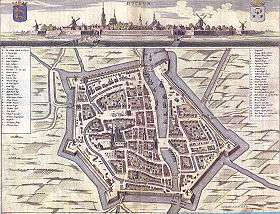Dokkum
| Dokkum | |||
|---|---|---|---|
| Town | |||
| |||
 | |||
| Country |
| ||
| Province |
| ||
| Population | |||
| • Total | c. 12,500 | ||

Dokkum is a Dutch fortified town in the municipality of Dongeradeel in the province of Friesland. It has 12,635 inhabitants (January 1, 2013). The fortifications of Dokkum are well preserved and are known as the bolwerken (bulwarks). It the fifth-most popular shopping city in Friesland. It also has the smallest hospital of the Netherlands.

History
| Historical population | ||
|---|---|---|
| Year | Pop. | ±% p.a. |
| 1511 | 1,400 | — |
| 1689 | 3,177 | +0.46% |
| 1744 | 2,855 | −0.19% |
| 1795 | 2,682 | −0.12% |
| Source: Lourens & Lucassen 1997, pp. 11-12 (1511–1795) | ||
The best known event in Dokkum's history is the martyrdom of the Anglo-Saxon missionary Saint Boniface in 754. Oliver of Cologne preached the Fifth Crusade in Dokkum in 1214 and Dokkum sent a contingent; the crescent in the coat of arms of Dokkum refers to this event. Dokkum acquired city rights in 1298. In 1572 Dokkum was sacked by the Spaniards after it had joined the Dutch Revolt. In 1597, the Admiralty of Friesland was established in Dokkum. However, it was moved to Harlingen in 1645. In 1971 the city was included in the list of Dutch 'Urban and village conservation areas'.[1]
Architecture
Town hall
The town hall in Dokkum was built in 1610.
Churches
- Grote of Sint-Martinuskerk which is from the 16th century.
- Sint-Bonifatiuskerk from 1871.
- Bonifatiuskapel is from 1934
Transport
Dokkum had a station (Dokkum-Aalsum) on the North Friesland Railway, which opened in 1901. It became the terminus for passenger services in May 1935 and closed to passengers in July 1936. The station reopened to passengers in May 1940 and closed to passengers in July 1942. Freight services ceased in 1975. There is still a bus station in Dokkum.
Sport
In the 200 km ice skating marathon known as the Elfstedentocht, Dokkum is known as the keerpunt (turning-point in Dutch), because it is where the speedskaters turn and head back to Leeuwarden. There are two different soccer clubs in Dokkum, VV Dokkum and Be Quick Dokkum.
Windmills
In 1652, Dokkum had five windmills, these were all post mills.[2]
Dokkum has two windmills, cap mills, that are preserved and both of them are open to the public by appointment.[3][4] They are named Zeldenrust and De Hoop.
A third mill, De Marmeerin stood by the Woudvaart outside the town. Since 2014 the mill was moved to be restored to working order. After restoration it is to be rebuilt at De sûkerei open-air museum in Damwoude.[5]
Gallery
- Inner harbour
- View to a street
 Center of town around De Zijl, Dokkumer Grootdiep flowing underneath
Center of town around De Zijl, Dokkumer Grootdiep flowing underneath
People from Dokkum
Dokkum was the residence for much of her career of the pioneering midwife Catharina Geertruida Schrader (1656–1746). Other famous Dokkumers include:
- Gemma Frisius (1508-1555), scientist
- Lieuwe van Aitzema (1600-1669), prominent diplomat and historian
- Ulrik Huber (1636-1694), lawyer
- Rein Jan Hoekstra (1941), lawyer, member of the Council of State of the Netherlands
- Jan Posthuma (1963), 1996 volleyball Olympic gold medalist
- Sipke Jan Bousema (1976), TV-presenter
- Ingrid Woudwijk (1995), runner
Coordinates: 53°20′N 6°00′E / 53.333°N 6.000°E
References
- ↑ Urban and village conservation areas Netherlands
- ↑ Tonneel der Steden; Blaeu, 1652
- ↑ "Dokkum, Friesland" (in Dutch). Nederlandse Molendatabase. Retrieved 2008-04-25.
- ↑ "Dokkum, Friesland" (in Dutch). Nederlandse Molendatabase. Retrieved 2008-04-25.
- ↑ "Dokkum, Friesland" (in Dutch). Nederlandse Molendatabase. Retrieved 2010-01-07.
Literature
- Lourens, Piet; Lucassen, Jan (1997). Inwonertallen van Nederlandse steden ca. 1300–1800. Amsterdam: NEHA. ISBN 9057420082.
| Wikimedia Commons has media related to Dokkum. |

